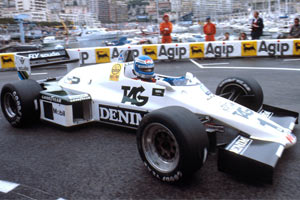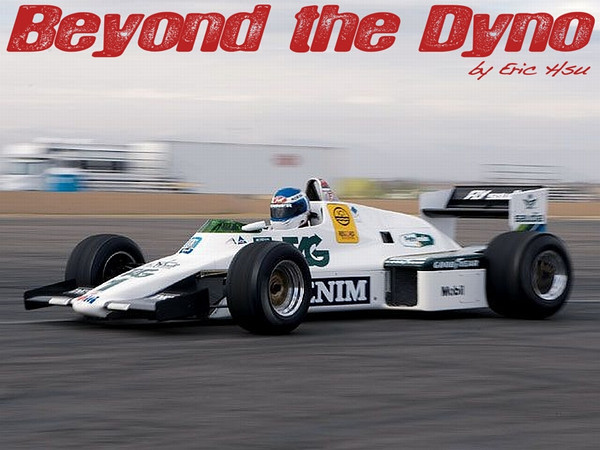The guys over at Tool Racing were prepping their Panoz DP02 for a 3 hour enduro at Buttonwillow this weekend so I dropped by the shop the other day to check up on the Cosworth YDT Duratec engine and setup a new Pi Research Sigma logger box (thanks for the help Mark). Afterwards I was shooting the shit with TJ over a double espresso (Tool has the ultimate espresso machine) and I noticed in between the early 2000s ALMS car and the longitudinal engine drift EVO (Tool is the ultimate toy shop) that the 1983 Williams was taken apart. TJ found a small fuel leak and had to remove the engine to get to it. When you remove an engine from an open wheel race car, you are basically removing half of the car so it looked like some major work was being done to my inexperienced open wheel eyes. But it probably took TJ only an hour since open wheel race cars are designed to be easy to work on. Anyhow it was very cool to check out a winning Williams FW08C taken apart. I've been really interested in vintage race cars and engines of all years since my visit to the Indianapolis Speedway's museum last month, but more on that later.

Here's the car at an F1 race in 1983.

Here's Erich driving the car at Buttonwillow recently.
The Williams FW08C-07 ran all 13 events in the 1983 F1 season. It took 1st at the Monaco GP and 2nd at the Detroit GP piloted by Keke Rosberg. It is powered by a 530bhp 3.0L Cosworth DFY. There are detailed specs on the car here at F1technical.net. The fact that this car has winning heritage is awesome.
The only thing that sucks was that I only had the camera phone so excuse the crap quality pictures.

The car is so light that it is sitting on some aluminum stands that aren't very beefy at all. The front appears to use a pull rod suspension. There is some carbon fiber here and there such as the nose and certain panels, but it is not widely used throughout the car. It's my guess that modern resin infusion techniques and tooling were not widely used yet in 1983. Or maybe car constuctors did not trust plastic (resin) yet. I don't believe they had finite element analysis super computers yet back in 1983. Mike and Steve told me that Nissan didn't even get super computers for FEA until 1990 or so.

All of the car's original livery is intact. The script above the word “Kingdom” is from some Saudi sponsor. Apparently in the 80's Bin Laden's father's company sponsored quite a few race cars.

The DFY was removed and sitting on a dolly. I really dig the headers. TJ is in the process of changing all of the fuel lines whether they were leaking or not.

Until the mid 1980's, mechanical injection was the norm for race engines. It must have been alot of fun tuning these engines with all of the orifices, pumps, lines, jets, etc….or not.

In the valley of the DFY's vee is the distributor and mechanical fuel injection distribution unit. Notice the OEM style electrical connectors. This was before the time of mil-spec connectors in race cars I'm guessing. The fuel distribution unit is directly in front of the distributor, but you can't really see it in this picture.

The tub appears to be completely made out of aluminum. This entire rear bulkhead behind the driver is the fuel cell. Inside of it is a giant bladder from top to bottom and from this rear panel you see to the driver. When you look inside it looks like a giant cavern. I think you can smuggle two small people inside of it.

Looking in the tiny pedal box you can see the that even the front section of the tub is made of aluminum. Erich normally wears a size 10 shoe, but he has to cram on size 8s just to fit his feet in the pedal box.

The driver's compartment is pretty tight and once again the aluminum tub construction is visible throughout. The round cyinder at the bottom is for the fire extinguisher system. The dash is very basic compared to today's F1 car. It only has a tach and a VDO water temp gauge. The tach is smaller than an Auto Meter Monster Tach so the next time you see a ricer with one in his automatic EG civic coupe with the fake ass Veilside body kit, make sure you make fun of his ass. Muscle cars are allowed Monster Tachs however.

Only the raw essentials are present. I believe the knob on the very left labeled “front” is brake bias, OFF is to turn off the engine, Reverse is to disengage the reverse lock out, Light is for the gauge back lighting, Isol' is to isolate the battery during jumper battery assist starting, and I'm not completely sure what Pump is for, but I'm guessing it is a feeder fuel pump for the mechanical fuel pump. Fire is probably to actuate the fire system. I'm not sure what the amber light is on top of the dash, but I'm guessing its some kind of “oh shit” warning light. The red mark on the tach is at 10,500rpm, but back in 1983 race spec the engine's redline was 11,200rpm. There's no need to beat the shit out of the engine in vintage racing.

This is a real deal Williams. How cool would it be to have this car in your garage?

The driver's seat isn't in place, but here you can see more of the tub's aluminum construction and the front side of the fuel cell which the driver's seat is actually resting on. Even the small piece of roll bar tubing on top of the fuel cell is a small gusseted aluminum tube structure. As you can see, pure aluminum construction doesn't make this thing the safest car to be driving, but I'm guessing that most of the F1 cars of the era are similar in construction. Race car drivers back then had balls of steel.

There are four piston AP brakes, but not in the usual way that you and I would think of “four piston brakes”. This must have been cutting edge stuff back then where the engineer says to the fabricator, “Let's add another caliper on the other side, mate.”
So there you have a 1983 era F1 car in detail. This particular car did well in tight and twisty tracks such as Monaco with Rosberg driving because the engine was responsive being normally aspirated, powerful enough but not out of control with turbo torque, and agile. The problem was horsepower could overcome handling at most of the other tracks so turbo powered cars started to win more often. In 1984, Williams moved to turbo power with Honda with the FW09 and did not return to Cosworth power until 2006.
When I get around to it, I'll put up some pics from the Indianapolis Speedway museum with plenty of super cool old race car tech. Its good to see how things used to be and how they became what they are today. I particularly like looking at older race cars because you can see how the engineers, fabricators, and mechanics solved problems. You can gain a whole new perspective on things and appreciate modern technology a bit more.



